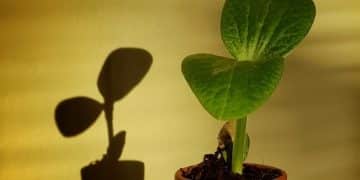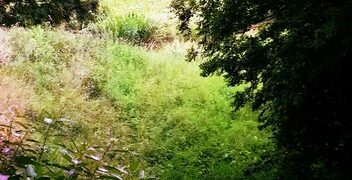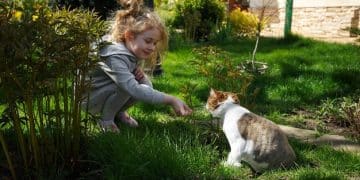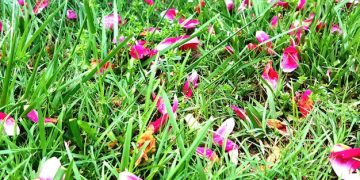Cut Your Waste in Half: Your Home Composting Guide for 50% Less Landfill Waste
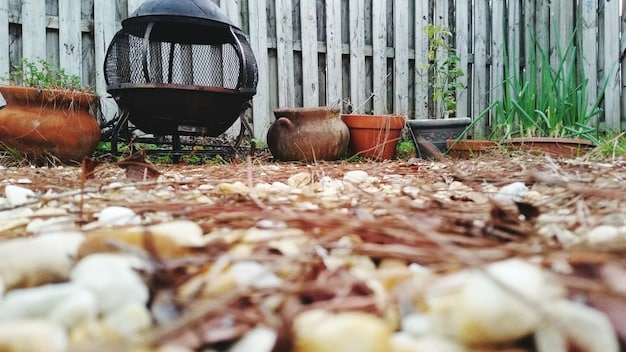
Composting at home offers a tangible, impactful way to significantly reduce household waste, contributing to a substantial decrease in landfill volume and fostering a healthier, more sustainable environment.
In a world grappling with mounting environmental concerns, the simple act of composting at home emerges as a powerful solution, offering a direct path to significantly cut your waste in half: a step-by-step guide to composting at home, reducing landfill waste by 50%. This guide delves into the practicalities and profound benefits of transforming organic waste into a valuable resource, benefiting both your garden and the planet.
The Imperative of Composting: Why Now?
The sheer volume of waste generated by households globally presents an overwhelming challenge. Landfills are rapidly reaching capacity, leaching harmful methane and other greenhouse gases into our atmosphere. This unsustainable trajectory demands immediate, scalable solutions.
Composting, often seen as a niche activity, is in fact a cornerstone of sustainable living, readily implementable by almost anyone. It transforms what was once considered “waste” into a valuable soil amendment, closing the loop on organic matter and enriching our natural environment instead of degrading it. Beyond the immediate benefit of reducing landfill burden, composting cultivates a deeper connection with the food we eat and the earth that sustains us.
Understanding the Environmental Impact of Food Waste
Food waste is not merely an aesthetic problem; it’s a significant environmental hazard. When organic materials decompose in anaerobic (oxygen-poor) conditions, such as those found deep within landfills, they produce methane. This gas is a greenhouse gas far more potent than carbon dioxide, contributing substantially to climate change.
- Potent Greenhouse Gas: Methane’s global warming potential is approximately 28 times greater than CO2 over a 100-year period.
- Resource Depletion: Wasting food also wastes all the resources—water, energy, labor—used to produce, process, and transport it.
- Soil Degradation: Organic matter in landfills doesn’t return nutrients to the soil, contributing to a nutrient-deprived agricultural cycle.
By diverting food scraps and yard waste from landfills, composting directly mitigates these issues. It’s a proactive step that every household can take to reduce their carbon footprint and promote a healthier planet. The simple act of separating greens and browns can have a ripple effect, moving us away from a linear “take-make-dispose” economy towards a more circular and restorative model.
The benefits extend beyond the purely environmental. Composting fosters a more resilient and self-sufficient lifestyle, reducing reliance on externally sourced fertilizers and promoting local food systems. It’s an investment in the future of our planet, one kitchen scrap at a time.
Getting Started: Choosing Your Composting Method
Embarking on your composting journey doesn’t require a large backyard or specialized equipment. Numerous methods cater to different living situations, space constraints, and commitment levels. The key is to select a system that aligns with your lifestyle to ensure long-term success.
Whether you live in an apartment with a small balcony or have ample garden space, there’s a composting solution for you. Understanding the basics of each method will help you make an informed choice that integrates seamlessly into your routine.
Outdoor Composting: Bins vs. Piles
Outdoor composting is the most traditional method, ideal for those with some garden space. It typically involves either a dedicated compost bin or an open pile.
- Compost Bins: These range from simple plastic tumblers to multi-chamber systems. Tumblers allow for easy turning, accelerating decomposition, while stationary bins (like wire or pallet constructions) are more hands-off. Bins help contain the material, control odors, and maintain heat.
- Compost Piles: A simpler approach, suitable for larger volumes of waste. Piles are essentially heaps of organic material directly on the ground. While less contained, they are highly effective when properly managed. Regular turning and proper balancing of “greens” and “browns” are essential.
Each outdoor method requires adequate space and protection from pests. Consider sunlight exposure, proximity to your home, and ease of access when deciding on a location. Ensure good air circulation around your compost to promote aerobic decomposition, which prevents foul odors and speeds up the process.
Maintenance for outdoor systems typically involves layering materials, ensuring adequate moisture, and turning the pile periodically. This aeration is crucial for the microbial activity that breaks down organic matter efficiently. Neglecting these aspects can lead to slow decomposition or anaerobic conditions, resulting in unpleasant smells.
Indoor Composting: Worms (Vermicomposting) and Bokashi
For apartment dwellers or those with limited outdoor space, indoor composting offers viable alternatives that are surprisingly odor-free when managed correctly.
- Vermicomposting: This method utilizes red wiggler worms to break down food scraps into nutrient-rich “worm castings.” A worm bin can be kept indoors, such as in a kitchen, closet, or basement. It’s a quiet, efficient, and fascinating process. The worms consume organic matter and excrete a highly fertile soil amendment.
- Bokashi Composting: Originating from Japan, Bokashi is not true composting but rather a fermentation process. Food scraps (including meat and dairy, which are generally excluded from other composting methods) are anaerobically fermented in a sealed bucket using a special inoculant. The fermented material is then buried in the garden or added to an outdoor compost pile for rapid breakdown.
Both indoor methods provide excellent solutions for diverting food waste. Vermicomposting produces high-quality fertilizer directly, while Bokashi rapidly processes a wider range of organic materials. Choosing between them depends on your preference for process and end product. Worm bins are often preferred for continuous processing of smaller amounts of scraps, while Bokashi is excellent for batch processing and accommodating more diverse food waste types.
These indoor systems require minimal space and can be surprisingly clean and unobtrusive. The key to success lies in understanding the specific needs of each method—whether it’s feeding your worms the right balance of food or ensuring your Bokashi bin is properly sealed. With a little attention, indoor composting can be a highly rewarding experience.
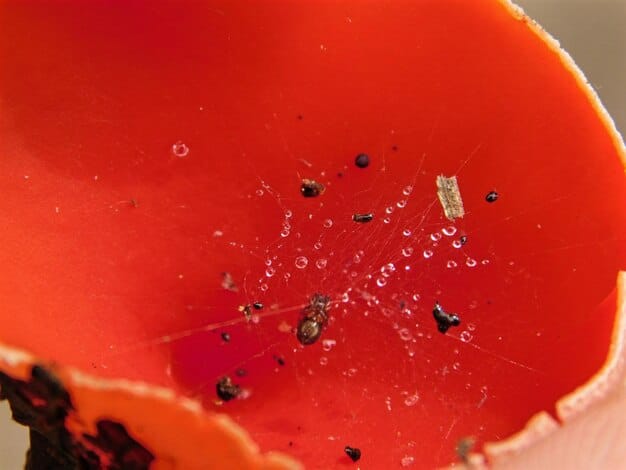
The Science of Composting: Greens, Browns, and the Right Ratio
Successful composting hinges on understanding the basic science behind it: the balance of carbon-rich “browns” and nitrogen-rich “greens,” along with appropriate moisture and aeration. This balance fuels the microscopic organisms responsible for decomposition, transforming your waste into a valuable soil amendment.
Think of it as a recipe. Just as a chef needs the right ingredients in the correct proportions, your compost pile needs the right mix of organic materials to thrive. An imbalanced pile will either decompose too slowly, smell foul, or fail to heat up properly.
Defining “Greens” and “Browns”
To achieve the ideal carbon-to-nitrogen (C:N) ratio, it’s crucial to differentiate between “greens” and “browns.”
- Greens (Nitrogen-rich): These materials tend to be fresh, moist, and high in nitrogen. They are the protein source for your compost microbes. Examples include kitchen scraps (fruit and vegetable peels, coffee grounds, tea bags), fresh grass clippings, and fresh plant trimmings. These provide the necessary fuel for rapid decomposition and heat generation.
- Browns (Carbon-rich): These materials are typically dry, woody, and high in carbon. They provide the energy source for the microbes and add bulk and structure to the compost pile, preventing compaction and ensuring good airflow. Examples include dried leaves, shredded cardboard, wood chips, straw, and newspaper.
A common mistake is adding too much of one category. An excess of greens can lead to a slimy, smelly pile, while too many browns will slow down decomposition considerably. The ideal C:N ratio for rapid composting is roughly 25-30 parts carbon to 1 part nitrogen. In practical terms, this often translates to a balance of approximately two to three parts brown materials for every one part green material by volume.
Maintaining this balance ensures that microorganisms have access to both the energy (carbon) and protein (nitrogen) they need to efficiently break down organic matter. It’s a dynamic process, and you’ll learn to adjust the mix based on the appearance and smell of your compost. A healthy pile should smell earthy, like forest soil, not putrid or sour.
Maintaining Moisture and Aeration
Beyond the greens and browns, two other critical factors for active composting are moisture and aeration.
- Moisture: Your compost pile should feel like a damp sponge – moist, but not soaking wet. Too dry, and microbial activity slows to a crawl. Too wet, and anaerobic conditions can set in, leading to foul odors and sluggish decomposition. You can add water if too dry, or add more browns if too wet. Rain often provides sufficient moisture for outdoor piles, but in dry spells, manual watering may be necessary.
- Aeration: Microbes thrive in oxygen-rich environments. Turning your compost pile regularly (once a week to once a month, depending on how quickly you want results) introduces oxygen, prevents compaction, and distributes heat and moisture evenly. Lack of aeration is a primary cause of anaerobic decomposition, leading to unpleasant smells.
Regular monitoring of moisture levels and periodic turning are simple steps that significantly enhance the efficiency of your composting process. For smaller setups like tumblers, simply rotating the bin provides the necessary aeration. For larger piles, a pitchfork or aeration tool can be used. These practices ensure a healthy, active compost system that quickly transforms your organic waste into nutrient-rich soil.
What to Compost: A Comprehensive List
Knowing what can and cannot go into your compost bin is fundamental to a successful and odor-free operation. While the general rule of “greens and browns” is useful, a detailed list ensures you’re feeding your compost the right materials and avoiding common pitfalls.
This section outlines common items found around the home and garden that are suitable for composting, along with those that should be avoided to prevent pests, odors, and contamination.
Compostable Materials: The “Yes” List
Many common household and garden waste items are ideal for composting:
- Kitchen Scraps: Fruit and vegetable peels, cores, scraps, coffee grounds, tea bags (staple removed), eggshells (crushed for faster breakdown), stale bread, pasta (plain), rice.
- Yard Waste: Grass clippings (thin layers to prevent matting), leaves, small twigs (chopped), untreated wood chips, straw, hay, prunings from plants (disease-free).
- Other Organics: Shredded newspaper (black ink only), cardboard (torn into small pieces, remove tape/labels), paper towels (unbleached, if possible, not used for harsh chemicals), used potting mix, dried flowers.
The key is variety and balance. Aim for a mix of different types of greens and browns to create a diverse microbial ecosystem within your compost. Smaller pieces decompose faster, so consider chopping larger items before adding them to the pile. This increases the surface area for microbial activity and prevents pockets of unprocessed material.
Remember that the smaller the pieces, the faster they will break down. For items like eggshells, crushing them significantly speeds up their integration into the compost. Consistency in chopping your scraps will yield a more uniform and quicker composting process, making your efforts more efficient and rewarding.
Materials to Avoid: The “No” List
While composting seems like a catch-all for organic waste, certain items should always be excluded to maintain a healthy pile and prevent problems:
- Meat, Bones, and Dairy Products: These attract pests (rodents, flies), can create foul odors, and break down very slowly.
- Oils and Greases: Cause odors, slow decomposition, and attract pests.
- Pet Waste (Dog and Cat Feces): May contain harmful pathogens that are not destroyed in home composting temperatures.
- Diseased Plants: Can spread pathogens to your garden when the compost is used.
- Weeds with Seeds: Seeds may survive the composting process and sprout in your garden.
- Chemically Treated Materials: Such as treated wood or plants sprayed with pesticides, as these chemicals can contaminate your compost and soil.
Avoiding these items is crucial for the health of your compost and your garden. The goal is to create a safe, nutrient-rich soil amendment, not a hazardous one. When in doubt, it’s always better to err on the side of caution and exclude the item. While some commercial composting facilities can handle these “no” items due to higher processing temperatures, standard home composting systems typically cannot.
Adhering to this “no” list prevents common issues like unpleasant smells, unwelcome visitors (pests), and the spread of plant diseases. A clean, healthy compost pile is a happy compost pile, and it will produce the best results for your gardening efforts.
Troubleshooting Common Composting Issues
Even with the best intentions, you might encounter a few hurdles on your composting journey. Common issues usually revolve around imbalance in materials, moisture, or aeration. The good news is that most problems are easily diagnosable and fixable, turning challenges into learning opportunities.
Understanding these common problems and their solutions will build your confidence and ensure your composting efforts remain productive and pleasant.
Odors: What Causes Them and How to Fix It
A healthy compost pile should smell earthy, not offensive. Foul odors are usually a sign of an imbalance.
- Rotten Egg/Sulfur Smell: This often indicates too much moisture and/or a lack of aeration, leading to anaerobic decomposition.
- Solution: Turn the pile to introduce oxygen. Add more “brown” materials (shredded cardboard, dry leaves) to absorb excess moisture and create more air pockets.
- Ammonia Smell: This means there’s too much nitrogen (too many “greens”) in proportion to carbon.
- Solution: Add more “brown” materials to balance the carbon-to-nitrogen ratio. Turn the pile to mix everything thoroughly.
- Sour/Fermented Smell: Often caused by too many wet food scraps or adding items like citrus rinds in large quantities without enough balance.
- Solution: Introduce more browns and turn the pile to aerate. Bury food scraps deeper within the pile to aid decomposition.
A good rule of thumb is to manage your compost content diligently, especially regarding food scraps. Burying fresh food waste deep within the pile helps prevent odors and deters pests. Regular turning is your best friend in preventing anaerobic conditions.
If you live in an area with particularly hot or humid weather, pay extra attention to aeration and moisture levels. Extreme conditions can exacerbate issues, making regular checks even more important for a harmonious composting process.
Pests: Keeping Unwanted Visitors Away
Pests like rodents, flies, and other critters are often attracted to compost piles that contain inappropriate materials or are not properly maintained.
- Rodents: Attracted to meat, dairy, oily foods, and sometimes uncovered food scraps.
- Solution: Never add meat, dairy, or oily foods to your compost. Bury all food scraps deeply within the pile. Use a rodent-proof compost bin with a secure lid and sturdy sides.
- Flies: Drawn to uncovered food waste, especially fruit and vegetable scraps.
- Solution: Always bury food scraps beneath a layer of “brown” material (leaves, soil, wood chips). Keep your compost moist but not soggy.
- Ants: Usually indicate a dry compost pile.
- Solution: Moisten the pile; ants prefer dry conditions.
Prevention is key when it comes to pests. A well-managed compost pile—one that is balanced, moist, and regularly turned—is far less attractive to unwanted guests. Investing in a good quality, enclosed compost bin can also provide an effective physical barrier against many common pests.
Remember that a healthy compost pile is a vibrant ecosystem, complete with beneficial insects and microorganisms. The goal is to discourage pests that cause nuisance or carry diseases, not to sterilize the environment. Proper maintenance will naturally foster the right kind of biological activity.
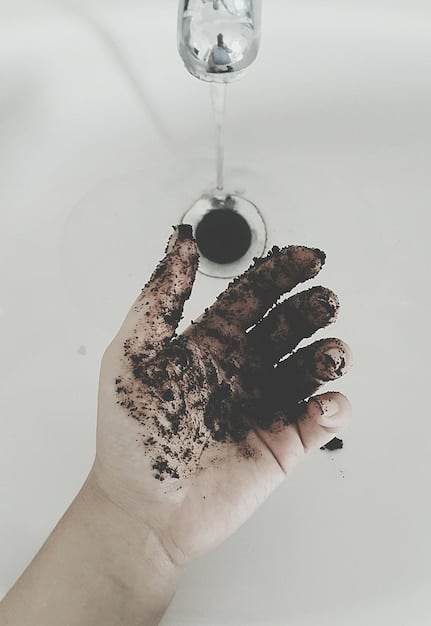
Harvesting and Using Your Finished Compost
After weeks or months of diligent layering and turning, the most rewarding part of composting arrives: harvesting your nutrient-rich “black gold.” Knowing when and how to collect this valuable soil amendment, and how to effectively integrate it into your garden, completes the composting cycle.
Finished compost is a game-changer for gardeners, transforming poor soil into a thriving ecosystem. It’s the ultimate payoff for your efforts in waste reduction.
Recognizing Finished Compost
Finished compost looks, feels, and smells like rich, earthy soil. Here are the key indicators:
- Appearance: It should be dark brown or black, crumbly, and uniform in texture. You should no longer be able to identify the original materials (like banana peels or coffee grounds), though some larger, slower-decomposing items (like small twigs) might still be present.
- Smell: It should have a pleasant, earthy scent, like forest soil after rain. There should be no offensive odors.
- Temperature: An active compost pile generates heat, but finished compost will be cool to the touch, indicating that the intense microbial activity has subsided.
- Volume: The volume of your compost pile will have significantly reduced by 50% or more, as organic matter breaks down.
The time it takes for compost to finish varies depending on the materials used, the method, and how actively you manage the pile (turning frequency, moisture levels). It can range from a few weeks in a hot, well-managed system to several months in a passive pile.
If you find a few larger pieces of unfinished material, you can either pick them out and return them to the active compost pile or simply spread them as they are; they will continue to break down in the soil. The presence of a few larger chunks won’t diminish the quality of your finished compost.
How to Use Your “Black Gold” in the Garden
Finished compost is an incredibly versatile and beneficial addition to any garden or landscape. It’s a natural fertilizer, soil conditioner, and a foundational element for healthy plant growth.
- Soil Amendment/Conditioner: Mix compost into garden beds before planting, or spread it onto the surface as a top dressing. It improves soil structure, water retention in sandy soils, and drainage in clay soils.
- Potting Mix Ingredient: Combine compost with other ingredients (like perlite, vermiculite, and peat moss or coir) to create a custom potting mix for containers.
- Mulch: Apply a layer of compost around plants as a weed suppressant, moisture retainer, and slow-release nutrient source.
- Compost Tea: Steep finished compost in water for a day or two to create a nutrient-rich liquid feed for your plants.
Start by incorporating a 1-2 inch layer of compost into your existing garden soil each year. This will gradually enhance soil health, leading to stronger, more productive plants that are less susceptible to pests and diseases. The beauty of compost is that you can’t over-apply it—it’s gentle on plants and consistently improves soil quality over time. It’s a fundamental input for organic gardening, building soil fertility naturally.
Using your own homemade compost is deeply satisfying. It’s a tangible outcome of your efforts to reduce waste and a direct contribution to the health and vitality of your garden, embodying the ultimate recycling process.
Beyond the Bin: Integrating Composting into a Zero-Waste Lifestyle
The act of composting, while powerful on its own, is often a gateway to a broader commitment to sustainable living and waste reduction. For many, seeing the dramatic decrease in their household trash can inspire further steps towards a truly zero-waste lifestyle. Composting is more than just managing waste; it’s a philosophy.
By understanding the impact of our consumption and disposal habits, we can make more conscious choices that benefit both our personal well-being and the health of the planet. This section explores how composting fits into a larger framework of mindful consumption and resource management, moving beyond the bin and into everyday choices.
The Circular Economy and You
Composting aligns perfectly with the principles of a circular economy, a model of production and consumption where existing materials and products are shared, leased, reused, repaired, refurbished, and recycled for as long as possible. This way, the life cycle of products is extended, reducing waste to a minimum.
- Closing the Loop: Composting turns organic “waste” into a valuable input (soil amendment), directly preventing it from becoming landfill waste and fostering new life.
- Resource Efficiency: By returning nutrients to the soil, composting reduces the need for synthetic fertilizers and intensive agricultural practices.
- Reduced Consumption: The habit of separating organic waste often leads to a greater awareness of overall waste production, encouraging conscious consumption and minimizing purchasing of packaged goods.
Embracing a circular mindset at home means thinking about the entire lifecycle of the products we use. Before purchasing, consider: can this be reused? Can it be repaired? Can it be recycled? And, if it’s organic, can it be composted? This shift in perspective transforms waste from an end-point to a resource.
Your compost bin acts as a miniature, personal circular economy. Every time you add a food scrap or yard clipping, you’re participating in a cycle of regeneration. This small act, when multiplied by millions of households, has the potential to drive massive change on a global scale.
Inspiring Others and Community Impact
Your composting efforts not only benefit your household and garden but can also inspire broader community impact. Leading by example is a powerful form of advocacy for sustainable practices.
- Education: Share your knowledge and experience with friends, family, and neighbors. Offer tips, show off your finished compost, or even host a small composting workshop.
- Community Composting: Explore or advocate for community composting programs in your area. Many cities offer food scrap drop-off points or curbside collection services, even for those who cannot compost at home.
- Advocacy: Support local policies that promote composting, organic waste diversion, and sustainable agriculture. Your voice can contribute to larger systemic changes.
The collective action of individuals embracing composting can significantly contribute to local and regional waste reduction goals. It fosters a sense of shared responsibility and community engagement, working towards a more resource-efficient society. Imagine if every household diverted 50% of their waste through composting—the impact would be monumental.
Composting is more than just a chore; it’s a statement. It’s a practical demonstration of environmental stewardship that resonates beyond your backyard. It embodies the principle that small, consistent actions can collectively lead to profound, positive change for our planet.
| Key Aspect | Brief Description |
|---|---|
| 🌱 Waste Reduction | Dramatically cuts landfill waste, often by 50%+. |
| 🌍 Eco-Friendly | Reduces methane emissions, improves soil health. |
| 🏡 Home Methods | Choose from outdoor bins, vermicomposting, or Bokashi. |
| 💰 Garden Benefits | Produces free, nutrient-rich soil amendment. |
Frequently Asked Questions About Composting
▼
The speed of composting varies significantly. With an ideal balance of greens and browns, proper moisture, and regular turning (hot composting), you can produce finished compost in as little as 3-4 months. Passive composting or less frequent turning might take 6-12 months. Factors like particle size and temperature also play a role in accelerating the decomposition process.
▼
A well-managed compost pile should not attract pests. The key is to avoid adding meat, dairy, or oily foods, and always bury fresh food scraps deep within the pile, covering them with “brown” materials. Using a secure, enclosed compost bin can also provide an additional layer of protection against rodents and flies, ensuring a clean and pleasant composting experience.
▼
Absolutely! Indoor composting methods like vermicomposting (using worms) or Bokashi composting are perfect for apartment dwellers. These systems are compact, virtually odor-free when properly maintained, and efficiently break down food scraps into valuable soil amendments. They allow you to participate in waste reduction regardless of your outdoor space, offering a practical solution for urban living.
▼
Compost tea is a liquid fertilizer made by steeping finished compost in water. To make it, place a handful or two of finished compost in a porous bag (like a old stocking) and suspend it in a bucket of water for 1-2 days. The resulting nutrient-rich liquid can be used to water plants, providing a gentle boost of easily absorbable nutrients. It’s a great way to extend the benefits of your compost.
▼
While most plant-based food waste is good for composting (fruit and vegetable scraps, coffee grounds), it’s generally recommended to avoid meat, bones, dairy products, and oily foods in home compost bins. These can attract pests, create foul odors, and break down very slowly. For these items, consider a Bokashi system, which can handle a wider range of food waste through fermentation.
Conclusion
Embracing home composting is more than just a trendy eco-conscious act; it’s a tangible, impactful step toward genuine environmental stewardship. This guide has illuminated the simplicity and profound benefits that emerge when you cut your waste in half: a step-by-step guide to composting at home, reducing landfill waste by 50%, transforming kitchen scraps and yard waste into a rich, life-giving resource. By understanding the balance of greens and browns, maintaining proper moisture and aeration, and troubleshooting common issues, you unlock the power to significantly reduce your household’s environmental footprint, enrich your garden, and contribute to a healthier planet. It’s an empowering journey that redefines waste, fostering a deeper connection to nature and a more sustainable future for all.
